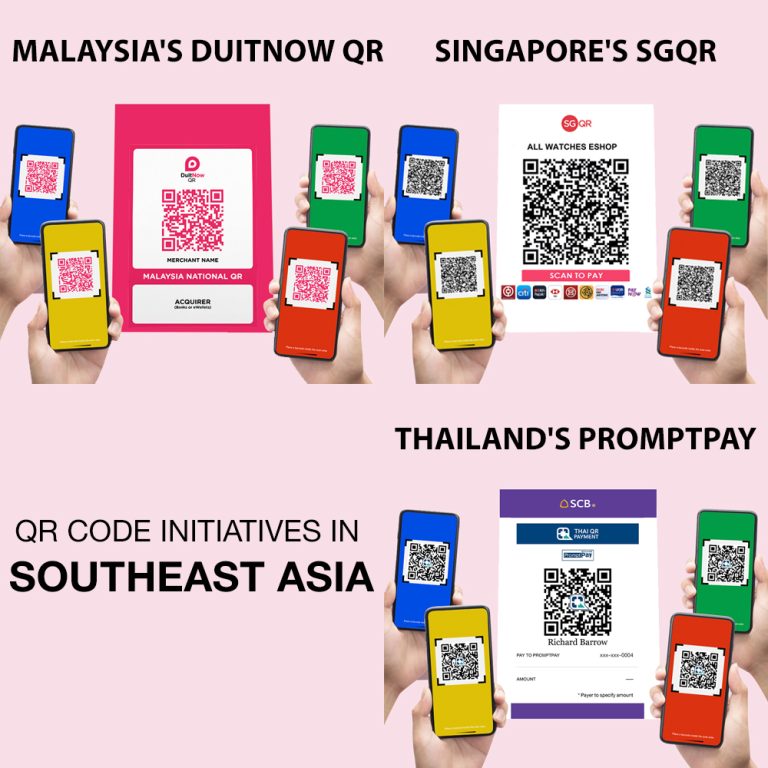
Shaking Up the Payment Scene: National QR Projects Taking Digital Payments in Southeast Asia to the Next Level!
Author : Monica
Introduction
In Southeast Asia, the adoption of QR code technology and cross-border payment connections is revolutionizing the digital payments landscape. Countries like Singapore, Malaysia, and Thailand are leading the charge, driving financial inclusion, convenience, and economic growth. This article explores the impact of QR codes and cross-border connections on Southeast Asia’s payment ecosystem.
QR Code Revolution in Southeast Asia:

Southeast Asia is witnessing a surge in QR code-based mobile payments, following in the footsteps of pioneers like China and South Korea. Countries like Singapore, Malaysia, Thailand, Indonesia, and the Philippines are leveraging QR codes to enhance convenience, promote financial inclusion, and stimulate economic growth. QR codes offer a user-friendly and cashless payment option, accessible through smartphones, even for those without traditional banking services.
Cross-Border Switch to Switch Connections:
One of the most exciting developments in the Southeast Asian payments landscape is the emergence of cross-border Switch to Switch connections. For example, Malaysia’s Payments Network Malaysia (PayNet) has established connections with its counterparts in neighboring countries like Singapore’s Network for Electronic Transfers (NETS) and Thailand’s National Interbank Transaction Management and Exchange (ITMX). These connections facilitate seamless transactions across different payment networks, promoting international commerce and regional
integration.
QR Code Initiatives in Southeast Asia:

1. Singapore’s SGQR Initiative: Leading the Charge Singapore’s SGQR initiative stands as a beacon of innovation in the Southeast Asian payment landscape. Developed by the Monetary Authority of Singapore (MAS) and the Infocomm Media Development Authority (IMDA), SGQR consolidates multiple payment QR codes into a single, interoperable platform. This initiative streamlines transactions, enhances convenience, and promotes interoperability among payment service providers, driving digital adoption and financial inclusion.
2. Malaysia’s DuitNow QR: Pioneering Interoperability In Malaysia, the DuitNow QR initiative is spearheading efforts to promote interoperability and drive cashless payments. Launched by Payments Network Malaysia (PayNet), DuitNow QR enables consumers to make payments seamlessly using a single QR code, regardless of their bank or e-wallet provider. This interoperable platform simplifies transactions, reduces friction for businesses and consumers, and accelerates Malaysia’s journey towards becoming a cashless society.
3. Thailand’s PromptPay: Revolutionizing Digital Payments Thailand’s PromptPay initiative has revolutionized the country’s digital payments landscape,driving financial inclusion and fostering economic growth. Developed by the Bank of Thailand (BOT), PromptPay enables individuals and businesses to transfer funds instantly using their mobile phone numbers or National ID numbers. This initiative has significantly reduced reliance on cash, promoted digitalization, and empowered millions of Thais with access to formal financial services.
Embracing the Future of Payments:
As Southeast Asia embraces the future of payments, the region is poised for further innovation and expansion in the digital finance space. QR codes and cross-border payment connections pave the way for a more inclusive, efficient, and interconnected financial ecosystem. With increased collaboration, innovation, and a shared vision for the future, Southeast Asia is positioning itself as a global leader in financial innovation and technology.
Conclusion:

The wave of innovation in Southeast Asia’s payment landscape is driven by QR codes and cross-border payment connections. Initiatives like Singapore’s SGQR, Malaysia’s DuitNow QR, and Thailand’s PromptPay are reshaping the way people transact, fostering financial inclusion, and promoting economic growth. By embracing this payment revolution, businesses and consumers in Southeast Asia are paving the way for seamless, secure, and accessible transactions in the future.
